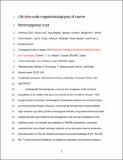Ultrafine-scale magnetostratigraphy of marine ferromanganese crust
Author(s)
Oda, Hirokuni; Usui, Akira; Miyagi, Isoji; Joshima, Masato; Weiss, Benjamin P.; Shantz, Chris; Fong, Luis E.; McBride, Krista K.; Harder, Rene; Baudenbacher, Franz J.; ... Show more Show less
DownloadOda_2011_open_access.pdf (384.3Kb)
OPEN_ACCESS_POLICY
Open Access Policy
Creative Commons Attribution-Noncommercial-Share Alike
Terms of use
Metadata
Show full item recordAbstract
Hydrogenetic ferromanganese crusts are iron-manganese oxide chemical precipitates on the seafloor that grow over periods of tens of millions of years. Their secular records of chemical, mineralogical, and textural variations are archives of deep-sea environmental changes. However, environmental reconstruction requires reliable high-resolution age dating. Earlier chronological methods using radiochemical and stable isotopes provided age models for ferromanganese crusts, but have limitations on the millimeter scale. For example, the reliability of 10Be/9Be chronometry, commonly considered the most reliable technique, depends on the assumption that the production and preservation of 10Be are constant, and requires accurate knowledge of the 10Be half-life. To overcome these limitations, we applied an alternative chronometric technique, magnetostratigraphy, to a 50-mm-thick hydrogenetic ferromanganese crust (D96-m4) from the northwest Pacific. Submillimeter-scale magnetic stripes originating from approximately oppositely magnetized regions oriented parallel to bedding were clearly recognized on thin sections of the crust using a high-resolution magnetometry technique called scanning SQUID (superconducting quantum interference device) microscopy. By correlating the boundaries of the magnetic stripes with known geomagnetic reversals, we determined an average growth rate of 5.1 ± 0.2 mm/m.y., which is within 16% of that deduced from the 10Be/9Be method (6.0 ± 0.2 mm/m.y.). This is the finest-scale magnetostratigraphic study of a geologic sample to date. Ultrafine-scale magnetostratigraphy using SQUID microscopy is a powerful new chronological tool for estimating ages and growth rates for hydrogenetic ferromanganese crusts. It provides chronological constraints with the accuracy promised by the astronomically calibrated magnetostratigraphic time scale (1–40 k.y.).
Description
http://geology.geoscienceworld.org/content/39/3/227.full.pdf+html
Date issued
2011-03Department
Massachusetts Institute of Technology. Department of Earth, Atmospheric, and Planetary SciencesJournal
Geology
Publisher
Geological Society of America
Citation
Oda, H. et al. “Ultrafine-scale Magnetostratigraphy of Marine Ferromanganese Crust.” Geology 39.3 (2011): 227–230. Web.
Version: Author's final manuscript